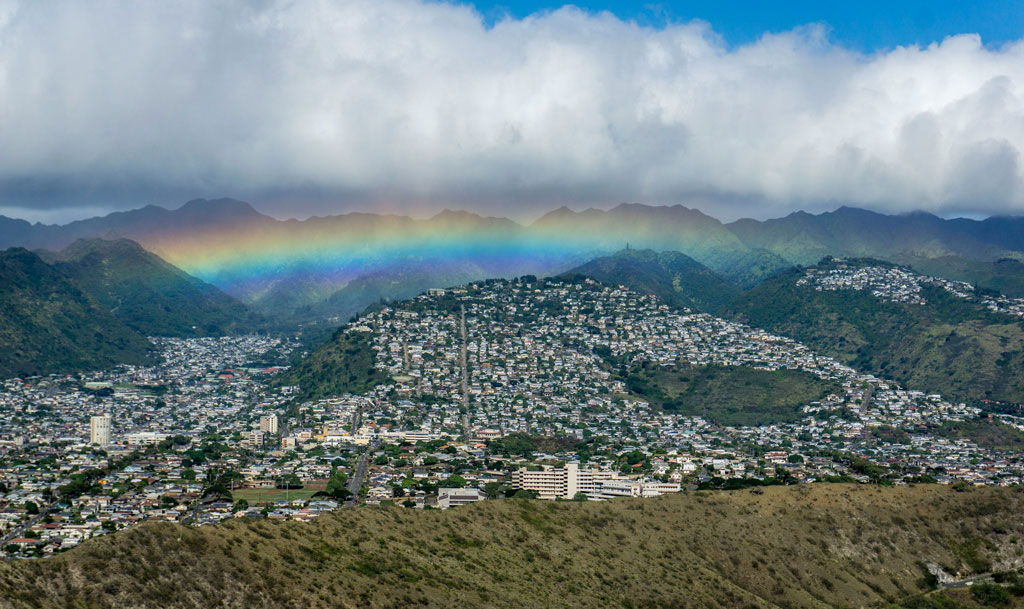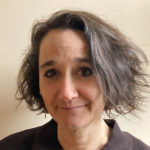Reflections on the Honolulu Meeting


The annual meeting in Honolulu last month debuted a new conference model for AAG, one strongly engaged with local history and current struggles, centering the knowledge, aspirations, and agency of our hosts. The nearly 3,800 geographers who gathered in person and the more than 1,000 who joined us online did all the normal annual meeting things: presenting our research, honoring one another’s accomplishments, competing in the GeoBowl, and catching up with colleagues. But we did so while embracing our kuleana as guests in Kanaka Māoli territory, building reciprocal relations by listening with care, participating in land engagements and workshops, and giving our labor and money via the Pledge to our Keiki. The result was an annual meeting deeply grounded in place, a celebration of both the long tradition of place-based “muddy boots” geography and the lived experiences and scholarship of our hosts.
A New Model: Place-based Annual Meetings
The journey to this new reciprocal, place-based model for AAG annual meetings began with a wave of critique from geographers on four continents who expressed substantive concerns about violating Kanaka Māoli sovereignty by holding the annual meeting on O‘ahu. AAG responded by reaching out to Hawaiian geographers for guidance, and adopting the actions they recommended, including hiring an Indigenous Hawaiian local events coordinator, Neil Hannahs; developing a series of freely available webinars and resources that showcased Kanaka Māoli history, culture, and knowledge as well as the military and settler colonial actions that have reshaped the islands over the last two centuries; and giving free admission to 65 Indigenous students from across the Pacific Basin.
One of the most powerful parts of the new approach to the annual meetings for me was the featured sessions highlighting Kanaka Māoli scholars and leaders. Explorer, Pwo navigator, and cultural revivalist Nainoa Thompson, this year’s Honorary Geographer, offered both a powerful history of the collective work to recover traditional Hawaiian navigation practices. Thompson also offered the most inspiring description of geography and the work geographers can do in the world that I have ever heard.
“Geographers today in the 21st century clearly understand the importance of the earth. They are navigators for tomorrow who are able to view the world not just from its physical and ecological space but also from humanity’s relationship to it. They look at the whole earth and all of humanity and that relationship so that they can help us make better choices to create a sail plan that will take us to a future that is good enough for our keiki.”
Thanks to the hybrid format of the meeting, this session was both live-streamed and recorded. If you missed it, I strongly encourage you to watch the recording.
I am delighted by the many geographers who have shared their gratitude for the new approach to the annual meeting.
The intellectual and emotional resonance of the Honolulu meeting was the labor of many hands. The 2022 annual meeting of the New Zealand Geographical Society in Christchurch was a crucial inspiration, demonstrating the power of a more bi-cultural academic practice. Another crucial component was AAG’s willingness to change its approach to annual meetings: departing from long-established practices to create a new template for the conference was a huge commitment. The local organizing committee members (Reece Jones, Neil Hannahs, Aurora Kagawa-Viviani, Kathryn Besio, Kamakanaokealoha Aquino, Abigail Hawkins, Kevin Woods, Serge Marek, Orhon Myadar, Borjana Lubura-Winchester, Subhashni Raj, Drew Kapp, Sa’iliemanu Lilomaiava-Doktor, Lisa Shirota, Christopher Knudson, and Barbara Quimby), too, had the hard work of inventing new practices and deepened engagements. Many specialty groups ensured the reciprocal spirit extended throughout the meeting by choosing speakers from Pacific Basin groups, and dozens of session organizers embraced the conference themes of Reciprocal Scholarship/ʻAʻohe pau ka ‘ike i ka hālau hoʻokahi; Colonialism and Resources/He aliʻi ka ‘āina, he kauwā ke kānaka; and Recovery and Restoration/Mōhala i ka wai ka maka o ka pua.
Most importantly, Kanaka Māoli leaders and scholars were willing to engage with us, to take our good faith efforts seriously and respond in kind.
Successful Nodes and Ongoing Climate Challenges
Carbon emissions from annual meetings remain a major challenge for AAG and learned societies more generally. I am delighted to report that we expanded to 11 nodes this year. A big shout out to the awesome folks at South Australia, Binghamton University and Southern Tier New York, California State University at Fullerton, George Washington University, Penn State, Rutgers, University of Colorado-Boulder, University of North Carolina-Chapel Hill, Toronto, Western Washington University’s Salish Sea Region, and University of Wisconsin-Milwaukee, who together hosted several hundred participants, and provided a robust, far less carbon-intensive approach.
Expanding nodes and other less carbon–intensive meeting practices will be crucial for addressing the carbon impact of future AAG meetings, but it will not be easy. At present, AAG depends on in-person annual meetings for nearly 50% of its revenue. That means that a virtual conference, or even a distributed hub and node model, would have a financial impact so substantial as to jeopardize the future of the organization.
AAG is in the process of changing its financial model to reduce the impact of the annual meeting, but finding a way to meet our commitment to carbon neutrality by 2045 while maintaining the fiscal health of the organization is a major challenge. AAG’s Climate Action Task Force will be working with AAG staff in hopes of developing a financially feasible, less carbon-intensive model for our annual meetings.
Onward to Detroit!
Engaging with place at annual meetings is an inspiring new model for AAG, but it will take time and effort from all of us to keep it going. AAG staff and incoming AAG President Patricia Ehrkamp have already begun planning for the 2025 meeting. As we did in Honolulu, we can support a reciprocal, place-based annual meeting by embracing our responsibility as guests in Detroit, building relations by listening with care, participating in land engagements and workshops, and giving back with our labor and money.
More specifically, I encourage you to start thinking about Detroit-focused speakers for your specialty group’s annual lectures, and to engage conference themes in the sessions you plan. Watch for opportunities to educate yourself about Detroit: its history and current struggles, and the local knowledge, aspirations, and agency of our hosts. And come to the annual meeting in 2025 with a spirit of curiosity, engagement, and reciprocity. I look forward to seeing you there!
Please note: The ideas expressed in the AAG President’s column are not necessarily the views of the AAG as a whole. This column is traditionally a space in which the president may talk about their views or focus during their tenure as president of AAG, or spotlight their areas of professional work. Please feel free to email the president directly at rlave [at] indiana [at] edu to enable a constructive discussion.


